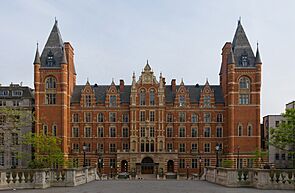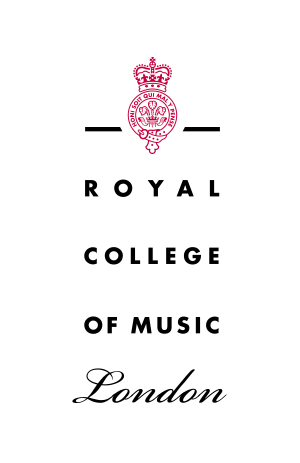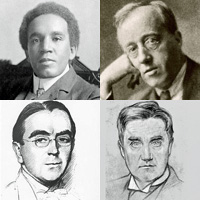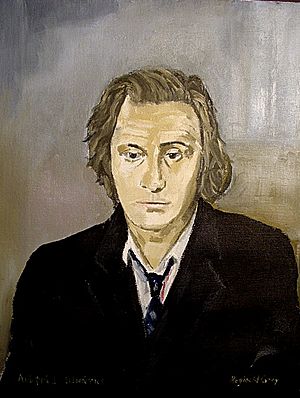Royal College of Music facts for kids

Front façade of the Royal College of Music
|
|
| Type | Public |
|---|---|
| Established | 1882 |
| Endowment | £47.9 million (2024) |
| Budget | £37.1 million (2023/24) |
| Chairman | Guy Black, Baron Black of Brentwood |
| Director | James Williams |
| Patron | Charles III |
| Students | (2015/16) |
| Undergraduates | (2015/16) |
| Postgraduates | (2015/16) |
| Location |
Prince Consort Road, London
,
51°29′59″N 0°10′37″W / 51.49972°N 0.17694°W |
| Campus | Urban |
| Affiliations | Conservatoires UK Associated Board of the Royal Schools of Music Universities UK |
 |
|
The Royal College of Music (RCM) is a famous music school in South Kensington, London, UK. It was officially started by a special royal document in 1882. The RCM teaches students from their first year of college all the way to getting a doctorate degree.
Students learn about all kinds of Western music. This includes how to perform, write music (composition), lead orchestras (conducting), and understand music theory and history. Many important musicians from around the world have studied here. The RCM also does research into how music is performed and how it affects people.
More than 900 students from over 50 countries attend the RCM. Their teachers are often world-famous musicians. The college is one of four main music schools that work together in the UK. Its buildings are right across from the Royal Albert Hall on Prince Consort Road. It is also near Imperial College and many museums in an area called Albertopolis.
Contents
History of the RCM
How the College Started
The Royal College of Music opened in 1883. It took the place of an earlier school called the National Training School of Music (NTSM). The idea for a music school in London had come from Albert, Prince Consort many years before. Other big European cities had conservatories to train young musicians. But London's main music school, the Royal Academy of Music, was not training enough professional musicians. In 1870, it was thought that less than 10% of orchestra players in London had studied there.
The NTSM opened in 1876 with Arthur Sullivan as its leader. However, the NTSM did not work out well. By 1880, a group of music experts said the school was not organized enough. Sullivan left in 1881. The original plan was to combine the Royal Academy of Music and the NTSM. The NTSM agreed, but the Royal Academy did not.
In 1881, George Grove helped create a plan for a new music school. The Prince of Wales also supported this idea. The Royal College of Music then moved into the old NTSM building. It officially opened on May 7, 1883. George Grove became its first director. There were 50 students who won scholarships and 42 students who paid for their lessons.
The Early Years of Music Training
George Grove believed the new college was a step forward from the NTSM. He wanted the RCM to be a great place for training orchestra players. He had help from violinist Henry Holmes and composer Charles Villiers Stanford. They thought a strong college orchestra would help instrumental students. It would also let composition students hear their music played live.
The first group of scholarship students included 28 who played orchestra instruments. The college orchestra could have many violins, violas, cellos, and other instruments. Grove hired 12 professors for orchestral instruments. He also hired famous teachers for other music areas. These included Jenny Lind (singing), Hubert Parry (composition), and Ernst Pauer (piano).
The first building became too small. So, a new building was planned in the early 1890s on Prince Consort Road. The new building was designed by Sir Arthur Blomfield. It was built with red brick and light-colored stone. Construction began in 1892, and the building opened in May 1894. Much of the money for the building came from Samson Fox, a businessman. His statue is in the entrance hall. Grove retired in 1894, and Hubert Parry became the new director.
Later Developments
After Hubert Parry, many other directors led the RCM. These included Sir Hugh Allen (1919–37) and Sir George Dyson (1938–52). The current Director, James Williams, started in September 2024.
More than 200 musicians teach at the college today. Many are famous worldwide. Some of these include Dmitri Alexeev, Natalie Clein, and Maxim Vengerov. Teachers also include leaders from major London orchestras.
The RCM has been connected to the British royal family since it started in 1882. King Charles III is currently its Patron. For 40 years, Queen Elizabeth The Queen Mother was the president. In 1993, Charles III (who was then Prince of Wales) became president.
In 2016, the RCM opened Prince Consort Village. This is a place for over 400 students to live. It has special soundproof bedrooms and practice rooms. The college is also a registered charity in England.
What Students Learn
The college teaches all parts of Western classical music. Students can study from their first year of college up to getting a doctorate. There is also a junior department. Here, 300 children aged 8 to 18 come for music lessons on Saturdays.
International Partnerships
Since August 2011, the RCM has worked with the Nanyang Academy of Fine Arts in Singapore. They now offer college and postgraduate degree programs together. Students get degrees from both schools.
Places to Perform
The RCM has many places for concerts and performances. The Amaryllis Fleming Concert Hall seats 468 people. It was built in 1901 and updated in 2008–09. The Britten Theatre holds 400 people. Queen Elizabeth II opened it in 1986. It is used for opera, ballet, and other shows.
There is also a smaller recital hall that seats 150 people. It was built in 1965. There are also several smaller rooms for recitals, including three Parry Rooms with organs.
A big £40 million project was finished in 2021. This almost doubled the size of the college's buildings. It added two new performance spaces. The Performance Hall seats 140 people. The Performance Studio was improved in 2023. It now has advanced technology for sound and visual effects.
Royal College of Music Collections
The Royal College of Music Museum has over 14,000 items. These show how music has been made for more than 500 years. One special instrument in the museum is a clavicytherium. It is thought to be the oldest keyboard instrument still existing. The museum also has the earliest known guitar. The Museum was greatly improved in 2020–21 after a £3.6 million investment.
The RCM also has many important old music items. These include original handwritten music from the 1400s onwards. You can see Anne Boleyn's Music Book and Chopin's Minute Waltz. There are also pieces by Elgar, Haydn, and Mozart. The collection also has music by Herbert Howells and Frank Bridge, and film scores by Stanley Myers.
The RCM has over 300 original paintings. These include a painting of Weber from 1826 and Haydn from 1791. A newer painting is of the Russian composer Alfred Schnittke by Reginald Gray. There are also 10,000 prints and photos. This is the largest collection of images of musicians in the UK. The RCM has 600,000 concert programs. These show concert life from 1730 until today. There are also more than 800 musical instruments and accessories from about 1480 to now.

Famous Alumni
Since it opened in 1882, the college has had many famous teachers and students. Many of the composers who helped create the "English Musical Renaissance" of the 19th and 20th centuries studied here.
Students who studied with Stanford and Parry included Samuel Coleridge-Taylor, Gustav Holst, Ralph Vaughan Williams, and John Ireland. Later famous students include Benjamin Britten, Sir James Galway, Dame Joan Sutherland, and Andrew Lloyd Webber.
Directors of the RCM
- Sir George Grove (1882)
- Sir Hubert Parry (1895)
- Sir Hugh Allen (1918)
- Sir George Dyson (1938)
- Sir Ernest Bullock (1953)
- Sir Keith Falkner (1960)
- Sir David Willcocks (1974)
- Michael Gough Matthews (1985)
- Dame Janet Ritterman (1993)
- Colin Lawson (2005)
- James Williams (since 2024)
Awards and Honors
The Royal College of Music gives out several awards. These include ARCM (Associate), LRCM (Licentiate), and FRCM (Fellow).
Each year, the RCM also gives special honorary degrees and memberships. These are given to people who have made a great difference to the RCM and to the world of music.
See also
 In Spanish: Real Colegio de Música para niños
In Spanish: Real Colegio de Música para niños
- List of music museums
- Royal College of Music war memorial


